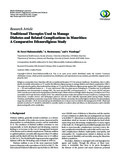| dc.contributor.author | Mahomoodally, MF | |
| dc.contributor.author | Mootoosamy, A | |
| dc.contributor.author | Wambugu, S | |
| dc.date.accessioned | 2017-06-07T11:03:12Z | |
| dc.date.available | 2017-06-07T11:03:12Z | |
| dc.date.issued | 2016 | |
| dc.identifier.citation | Mahomoodally, M. Fawzi, A. Mootoosamy, and S. Wambugu. "Traditional Therapies Used to Manage Diabetes and Related Complications in Mauritius: A Comparative Ethnoreligious Study." Evidence-Based Complementary and Alternative Medicine 2016 (2016). | en_US |
| dc.identifier.uri | https://www.ncbi.nlm.nih.gov/pubmed/27200100 | |
| dc.identifier.uri | https://www.hindawi.com/journals/ecam/2016/4523828/abs/ | |
| dc.identifier.uri | http://hdl.handle.net/11295/101024 | |
| dc.description.abstract | Religious communities from Mauritius still rely on traditional therapies (TT) for primary healthcare. Nonetheless, there is still a dearth of scientific information on TT used by the different religious groups to manage diabetes and related complications (DRC). This study aimed to gather ethnomedicinal knowledge on TT used by the different religious groups against DRC. Diabetic patients (n = 95) and traditional healers (n = 5) were interviewed. Fifty-two plant species belonging to 33 families and 26 polyherbal formulations were documented to manage DRC. The most reported DRC was hypertension (n = 36). Leaves (45.2%) and juice (36%) were the most cited mode of preparation of herbal recipes. Plants which scored high relative frequency of citation were Citrus aurantifolia (0.55) and Morinda citrifolia (0.54). The cultural importance index showed that Ocimum tenuiflorum, Cardiospermum halicacabum, Camellia sinensis, and Ophiopogon japonicas were the most culturally important plants among Hindu, Muslim, Christian, and Buddhist community, respectively. Hindu and Muslim community showed the highest similarity of medicinal plants usage (Jaccard index = 95.8). Seven animal species distributed over 4 classes were recorded for the management of DRC. Plants and animals recorded as TT should be submitted to scientific studies to confirm safety and efficacy in clinical practice and to identify pharmacologically active metabolites. | en_US |
| dc.language.iso | en | en_US |
| dc.publisher | University of Nairobi | en_US |
| dc.rights | Attribution-NonCommercial-NoDerivs 3.0 United States | * |
| dc.rights.uri | http://creativecommons.org/licenses/by-nc-nd/3.0/us/ | * |
| dc.title | Traditional therapies used to manage diabetes and related complications in Mauritius: a comparative Ethnoreligious study. | en_US |
| dc.type | Article | en_US |



